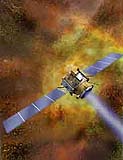| . |  |
. |
 The Technology of Deep Space
The Technology of Deep Spaceby Bruce Moomaw Cameron Park - February 1, 2000 - The general impression most people seem to have of the "Deep Space 1" mission -- the first of NASA's series of "New Millennium" space missions designed to test out new technological systems in space so that they can then be utilized on operational missions -- is that it ended as something of a fiasco. It successfully tested a xenon ion drive and 11 other newly developed technological systems early in its flight; but during its super-close, high-speed flyby of the tiny asteroid Braille last July 28, its new on-board "AutoNav" self-navigation system, which had already encountered some problems, was unable to lock onto the asteroid at all during the closest phases of its flyby. And so DS-1 completely failed to obtain any closeup photos of the asteroid. The only scientific information it ended up obtaining during the flyby was a set of near-infrared spectra of Braille's mineral makeup -- which largely just confirmed the belief that it was a detached fragment of the asteroid Vesta, a conclusion already reached on the basis of spectra taken a few months earlier by Earth-based telescopes. Its controllers had then hoped to resume thrusting with its ion engine and continue on to optional flybys of two comets in 2001. But in November, the craft's star tracker -- which provided DS-1 with crucial information on its roll pointing attitude, and which, ironically, was a routine piece of equipment rather than one of the new technologies -- failed completely (apparently due to a short circuit). And so, since DS-1 has been unable to get any accurate information on its roll attitude, it hs had to call a halt to its ion thrusting ever since. Not very encouraging-sounding -- but actually this gloomy portrayal of DS-1 as a spacegoing Mr. Magoo is deceptive. It turns out that DS-1's AutoNav system worked much better than most people think (its difficulties were actually due mostly to problems with another of DS-1's new technologies, its "MICAS" miniature camera and spectrometer package). And it also turns out that the spacecraft's career is far from over -- although the plan now is to fly it past only one comet in 2001, rather than the two originally planned. First, an account of the AutoNav affair: This genuinely revolutionary new system was designed to tremendously cut down on the extent to which the huge ground-based antennas of the Deep Space Network have to track deep space probes and calculate their trajectories (a procedure which broke down infamously in the case of Mars Climate Orbiter, and which is always expensive). During much of its flight, DS-1 observed and calculated its position in the Solar System by itself. Every week, it shut off its ion engine and spent 12 hours rolling around taking pictures of star fields with the CCD camera on its MICAS package, after which DS-1's computer was intended to compare these with its knowledge of the positions of fully 250,000 stars and 250 asteroids -- with the latter, seen against the starry background, serving as effective beacons from which AutoNav could calculate the craft's position with an anticipated accuracy of only 500 km. Deep Space One Special Report Go to Part Two
DEEP SPACE ONE
|
| |||||||||||
| The content herein, unless otherwise known to be public domain, are Copyright 1995-2016 - Space Media Network. All websites are published in Australia and are solely subject to Australian law and governed by Fair Use principals for news reporting and research purposes. AFP, UPI and IANS news wire stories are copyright Agence France-Presse, United Press International and Indo-Asia News Service. ESA news reports are copyright European Space Agency. All NASA sourced material is public domain. Additional copyrights may apply in whole or part to other bona fide parties. Advertising does not imply endorsement, agreement or approval of any opinions, statements or information provided by Space Media Network on any Web page published or hosted by Space Media Network. Privacy Statement All images and articles appearing on Space Media Network have been edited or digitally altered in some way. Any requests to remove copyright material will be acted upon in a timely and appropriate manner. Any attempt to extort money from Space Media Network will be ignored and reported to Australian Law Enforcement Agencies as a potential case of financial fraud involving the use of a telephonic carriage device or postal service. |